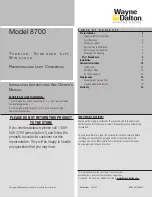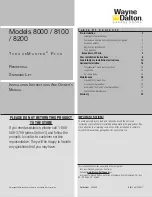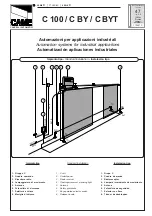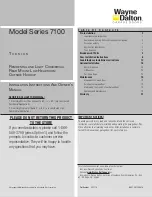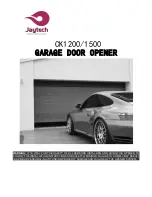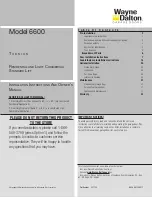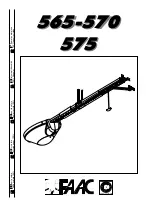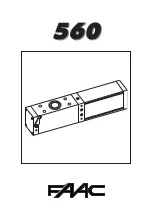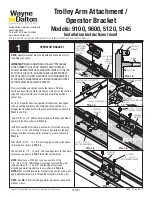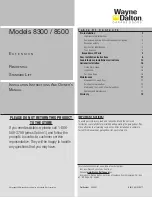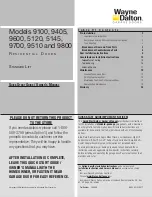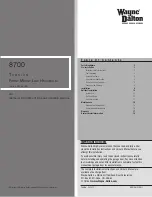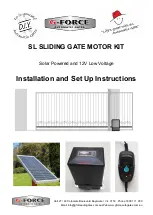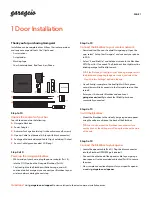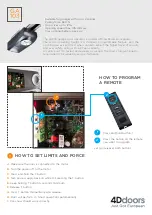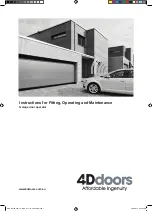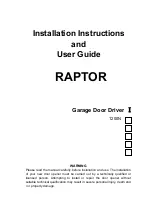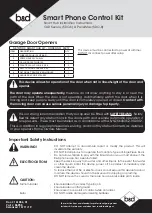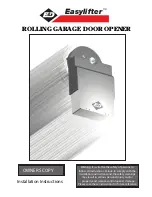
WARNING
FAILURE TO ENSURE TIGHT FIT OF CABLE LOOP OVER MILFORD PIN
COULD RESULT IN COUNTERBALANCE LIFT CABLE COMING OFF THE PIN,
ALLOWING THE DOOR TO FALL, POSSIBLY RESULTING IN SEVERE OR
FATAL INJURY.
TO ATTACH BOTTOM CORNER BRACKETS WITHOUT A STRUT:
Starting on the left hand
side, attach left hand bottom corner bracket to the left corner of the bottom section, making
sure it is seated to the edges of the end cap. Attach the bottom corner bracket to the end
stile using (3) 1/4” – 14 x 7/8” RED HEAD self drilling screws and 1/4” - 14 x 7/8” self drill-
ing screws. Repeat for other side.
1/4”-14 x 7/8”
Self drilling screws
Bottom corner
bracket
End
cap
Roller spacer
Short stem
track roller
Counterbalance
cable loop
Counterbalance
lift cable
Milford pin
Bottom
section
Bottom
weather seal
(3) 1/4”-14 x 7/8” Self
drilling screws (RED HEAD )
(3) 1/4”-14 x 7/8” Self
drilling screws (RED HEAD )
Bottom section
Short stem
track roller
Bottom
corner
bracket
Bottom
weather seal
Counterbalance
lift cable
Left hand
bottom corner
bracket
Cotter pin
Washer
Clevis pin
Counterbalance
cable loop
1/4”-14 x 7/8” Self
drilling screws
TO ATTACH BOTTOM CORNER BRACKETS WITH A STRUT:
Starting on the left hand side,
position the left hand bottom corner bracket to the left corner of the bottom section, making
sure it is seated against the edges of the end stile. Repeat for other side.
NOTE:
Refer to Strutting Schedule (shown on the Windload Specification Sheet), to determine
if a strut needs to be installed on top of the bottom corner brackets at the bottom portion of
the bottom section.
Next, position the strut over the bottom corner brackets and center the strut side to side on
the bottom section. Secure both the strut and the bottom corner bracket into the endstile
using (3) 1/4” – 14 x 7/8” RED HEAD self drilling screws and 1/4” - 14 x 7/8” self drilling
screws. Repeat for other side. Finish securing the strut to the bottom section using (2) 1/4” -
14 x 7/8” self drilling screws at each center stile(s) location.
1/4”-14 x 7/8”
Self drilling screws
Bottom corner
bracket
End
cap
Roller spacer
Short stem
track roller
Counterbalance
cable loop
Counterbalance
lift cable
Milford pin
Bottom
section
Bottom
weather seal
Strut
(3) 1/4”-14 x 7/8” Self
drilling screws (RED HEAD )
Bottom
section
Short stem
track roller
Bottom
corner
bracket
Bottom
weather
seal
Counterbalance
lift cable
Left hand
bottom corner
bracket
Cotter pin
Washer
Clevis pin
Counterbalance
cable loop
1/4”-14 x 7/8”
Self drilling screws
Strut
(3) 1/4”-14 x 7/8” Self
drilling screws (RED HEAD )
IMPORTANT:
THE 1/4” - 14 X 7/8” RED HEAD SELF DRILLING SCREWS MUST BE MUST BE
INSTALLED THROUGH THE HOLES OF THE BOTTOM CORNER BRACKETS, AS SHOWN.
NOTE:
Check to ensure cable loop fits tightly over the milford pins.
Insert a short stem track roller with roller spacer (if applicable) into the bottom corner
bracket. Repeat for other side.
NOTE:
Verify bottom weather seal (bottom seal) is aligned with door section. If there is more
than 1/2” excess bottom weather seal on either side, trim bottom weather seal even with
door section.
Graduated Hinge Attachment
Tools Required: Power drill, 7/16” Socket driver, Safety glasses, Leather gloves
7
NOTE:
Refer to door section identification, located in the pre-installation section of this
manual or refer to Parts Breakdown.
NOTE:
The graduated end and center hinges can be identified by the number stamped onto
their lower hinge leaf.
NOTE:
The #1, #2, #3, #4 graduated end hinges (Wide body) serves as end hinges on all
sections, except for the top section.
NOTE:
The #1 Center hinge(s) (Narrow body) serves as center hinges on all sections, except
for the top section.
Locate the bottom section, (2) #1 graduated end hinges (wide body) for the end stiles and
depending on the width of your door, enough #1 center hinge(s) (narrow body) for each of
the pre-marked center hinge locations. Starting on the left hand side of the bottom section,
align the lower hinge leaf of the #1 graduated end hinge over the holes, located at the top
of the end caps. Also, align the lower hinge leafs of the #1 center hinges (narrow body) with
the pre-marked locations at the center locations at the top of the section. Attach lower hinge
leafs to the section using 1/4” - 14 x 7/8” self drilling screws, as shown.
IMPORTANT:
ONCE THE 1/4” - 14 X 7/8” SELF DRILLING SCREWS ARE SNUG AGAINST THE
LOWER HINGE LEAFS, TIGHTEN AN ADDITIONAL 1/4 TO 1/2 TURN TO RECEIVE MAXIMUM
DESIGN HOLDING POWER.
IMPORTANT:
PUSH & HOLD THE HINGE LEAF SECURELY AGAINST THE SECTION WHILE
SECURING WITH 1/4” - 14 X 7/8” SELF DRILLING SCREWS. THERE SHOULD BE NO GAP
BETWEEN THE HINGE LEAF AND THE SECTION.
Place a short stem track roller into each graduated end hinge. Repeat graduated hinge
attachment using the appropriate graduated end hinges for all remaining sections except the
top section.
IMPORTANT:
WHEN PLACING SHORT STEM TRACK ROLLERS INTO THE #2 GRADUATED
END HINGES AND HIGHER, THE SHORT STEM TRACK ROLLER GOES INTO HINGE TUBE
FURTHEST AWAY FROM SECTION.
Use (2) #2 graduated end hinges (wide body) and the required number of #1 center hinge(s)
(narrow body) for each of the center hinge pre-marked location(s) along the top edge of the
lock section (second section).
Use (2) #3 graduated end hinges (wide body) and the required number of #1 center hinge(s)
(narrow body) for each of the center hinge(s) (narrow body) pre-marked location(s) along the
top edge of the intermediate I section (fourth section).
Use (2) #4 graduated end hinges (wide body) and the required number of #1 center hinge(s)
(narrow body) for each of the center hinge pre-marked location(s) along the top edge of the
intermediate II section (fifth section).
Use (2) #5 graduated end hinges (wide body) and the required number of #1 center hinge(s)
(narrow body) for each of the center hinge pre-marked location(s) along the top edge of the
intermediate III section (sixth section).
Use (2) #6 graduated end hinges (wide body) and the required number of #1 center hinge(s)
(narrow body) for each of the center hinge pre-marked location(s) along the top edge of the
intermediate IV section (seventh section).
Use (2) #7 graduated end hinges (wide body) and the required number of #1 center hinge(s)
(narrow body) for each of the center hinge pre-marked location(s) along the top edge of the
intermediate V section (eighth section).
8
Summary of Contents for 8700
Page 21: ......

